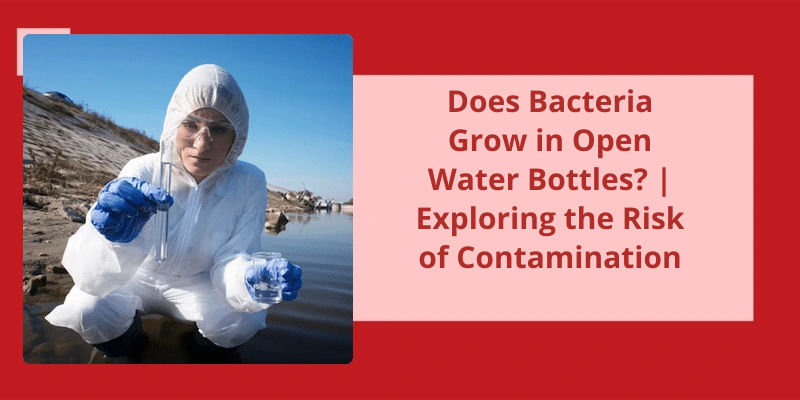In our modern age, we all know the importance of staying hydrated and carrying water bottles with us wherever we go. However, have you ever considered the potential health risks associated with improperly cleaning and storing your water bottle? It may come as a surprise, but bacteria can grow and thrive in your water bottle if it's not properly cleaned or stored, creating an environment ripe for numerous fungi and even mold. Whether you're using a plastic, metal, or even glass water bottle, they all have the potential to harbor harmful microbes if not taken care of regularly. The consequences of not taking proper precautions when it comes to your water bottle can lead to a range of health hazards, so it's essential to understand the risks and how to avoid them.
Can Bacteria in My Water Bottle Make Me Sick?
Weve all been there: youre on the go and don’t have access to clean drinking water, so you reach for your trusty water bottle. But did you know that the bacteria lurking inside your water bottle could make you sick? Bacteria like E. coli can grow in water bottles and cause symptoms like food poisoning or gastroenteritis. Mold is another culprit that can grow inside your bottle if it’s not cleaned properly.
It’s important to stay on top of cleaning your water bottle to prevent harmful bacteria and mold from growing. While washing the bottle itself is important, don’t forget about the smaller parts, like the cap or the straw. These areas can also harbor bacteria and need to be cleaned with a toothbrush or bottle brush.
But it’s not just about cleaning your water bottle. You also need to be mindful of where youre refilling it. If youre using a public water fountain or tap, theres a risk of contamination from other peoples germs. When possible, opt for bottled water or use a filtration system to ensure your water is clean and safe to drink.
In addition to cleaning your water bottle and being mindful of where youre refilling it, there are other steps you can take to reduce your risk of getting sick from bacteria in your water. For example, avoid leaving your water bottle in a hot car or in direct sunlight for extended periods of time. Bacteria thrive in warm, moist environments, so keeping your bottle cool and dry can help prevent growth.
The Impact of Plastic Water Bottles on the Environment and Alternatives to Single-Use Plastic Bottles
- Plastic water bottles are a major contributor to plastic pollution in our oceans and landfills.
- Most plastic water bottles aren’t recycled and instead end up in the trash.
- These bottles take hundreds of years to break down, and in the meantime, can harm wildlife and pollute our water sources.
- Thankfully, there are alternatives to single-use plastic water bottles, such as reusable bottles made from glass, stainless steel, or BPA-free plastic.
- By using a reusable water bottle, individuals can reduce their plastic footprint and help protect the environment.
It’s alarming to think that something as seemingly harmless as a water bottle can harbor harmful mold. Despite regular rinsing, it’s important to understand how mold can enter your bottle and how to properly clean it to avoid potential health risks.
How Does Mold Get Into a Water Bottle?
The presence of mold in water bottles is a common problem that many people experience but aren’t aware of. Once the spores are inside the bottle, they’ll begin to grow and multiply, creating colonies of mold that can be harmful to our health.
Water that’s contaminated with bacteria or other pathogens can be a breeding ground for mold, and it’s important to ensure that your drinking water is safe and clean. If you suspect that your water may be contaminated, it’s important to have it tested and treated by a professional.
Regular cleaning and maintenance of your water bottle, using hot water and soap, is essential to prevent mold growth.
The Health Risks Associated With Drinking Water Contaminated With Mold
- Inhalation of mold spores can lead to respiratory problems, including asthma and allergic reactions.
- Ingestion of water contaminated with mold can cause gastrointestinal issues, such as nausea and diarrhea.
- Exposure to mold has also been linked to skin irritation and headaches.
- Long-term exposure to mold-contaminated water may increase the risk of developing certain types of cancer.
- Individuals with weakened immune systems, such as those with HIV/AIDS or undergoing chemotherapy, are at an increased risk of health problems associated with mold exposure.
- To reduce the risk of health problems associated with mold-contaminated water, it’s important to regularly test water sources and remediate mold immediately if detected.
It’s advisable to regularly clean water bottles to prevent bacteria growth. However, a common question is how long it takes for bacteria to grow in a water bottle. Studies have revealed that noncarbonated natural mineral waters can experience bacterial growth within a few days after filling and storage at room temperature. This phenomenon has been known for over 40 years.
How Long Does It Take for Bacteria to Grow in a Water Bottle?
The length of time it takes for bacteria to grow in a water bottle varies depending on several factors. Firstly, the type of water that’s contained within the bottle can play a role. Noncarbonated natural mineral waters have been found to be particularly susceptible to bacterial growth. In fact, studies have shown that bacteria can begin to grow in such waters just a few days after filling and storage at room temperature. This is a phenomenon that’s been known for more than 40 years.
Bottles that haven’t been properly washed or that have been reused multiple times can harbor bacteria that can contribute to the growth of additional bacteria in the water. Furthermore, even new bottles can contain small amounts of bacteria that can quickly multiply given the right conditions.
The temperature of the water and the environment in which the bottle is stored can also be significant factors in the growth of bacteria. Warm temperatures provide an ideal environment for bacteria to flourish, and this is why it’s generally recommended that bottled water be stored in a cool, dry place. Exposure to sunlight can also promote bacterial growth, so keeping a water bottle out of direct sunlight is important if you want to prevent bacterial growth.
It’s worth noting that not all types of bacteria are harmful to humans. However, some types can cause serious health problems if consumed in large quantities, particularly for vulnerable individuals such as young children or the elderly.
By taking proper precautions, however, it’s possible to minimize the risk of bacterial growth and ensure that the water you drink is safe and healthy.
How to Properly Clean and Sanitize Water Bottles to Prevent Bacterial Growth
To clean and sanitize water bottles properly, wash them with soap and hot water, use a bottle brush to clean hard-to-reach areas, rinse thoroughly, and then soak in a solution with one tablespoon of bleach per gallon of water for two minutes. Finally, thoroughly rinse with hot water and let the bottle air dry.
Now that we know the best way to store an opened bottle of water, it’s important to consider whether or not it’s still safe to drink after a certain amount of time. While some may assume that bottled water never goes bad, the reality is that it can lose it’s freshness and potentially become contaminated if left for too long. So, how long is too long? Let’s take a closer look.
Is It Safe to Drink Old Opened Bottled Water?
When it comes to drinking old opened bottled water, the first question that should come to your mind is whether it’s safe or not. The answer to this question is a bit complicated. It depends on various factors like the storage method, the quality of the bottle, the temperature, and the duration of storage.
If you’ve opened a water bottle and kept it at room temperature for more than a few days, the chances are high that bacteria have started to grow in it. The longer the water stays at room temperature, the higher the risk of bacterial growth. Some bacteria, like E.coli and Salmonella, can cause severe health issues if you consume them.
However, if you store the opened water bottles in the fridge immediately after opening, you can slow down the bacterial growth. This is because bacteria grow faster at room temperature than in a cold environment. By keeping the opened bottle of water in the fridge, you can extend the shelf life of the water.
According to the shelf-life gurus at Still Tasty, a continuously refrigerated bottle of water can maintain quality for four to six days after opening. This means that you can safely drink the water within this duration without worrying about any bacteria growth. However, after this period, the water may not taste good, and there’s a risk of bacterial growth.
If the bottle is of low quality, it may leach chemicals and contaminants into the water, making it unsafe to drink. Therefore, it’s better to use only high-quality, BPA-free water bottles.
How to Properly Store Water Bottles to Reduce the Risk of Bacterial Growth
- Make sure the water bottles are completely dry before storing them
- Avoid storing water bottles in warm or humid areas
- Store water bottles in a cool and dry place
- Don’t store water bottles near cleaning chemicals or other substances that could contaminate them
- Replace water bottles frequently to prevent bacterial growth
- Wash water bottles with hot soapy water between uses
- Avoid reusing disposable water bottles as they aren’t designed for multiple uses
Conclusion
Merely rinsing them out with water may not always be sufficient to avoid the development of harmful microorganisms. Instead, proper cleaning techniques that take into account the moist environment and potential areas where bacteria can accumulate, such as attached straws and narrow-mouth lids, should be employed. By being vigilant about the cleanliness of our water bottles, we can enjoy safe and healthy hydration wherever we go.






